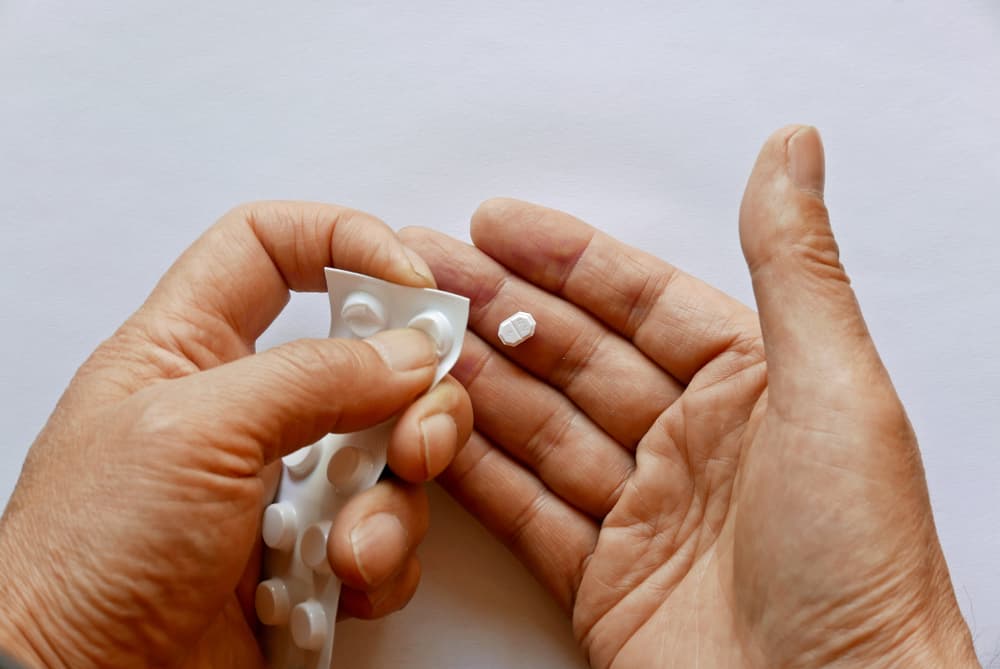Prednisone for Dogs

Medication details
- Medication type: Steroid
- Form: Liquid, Capsule, Tablet, Eye drops
- Prescription required? Yes
- Life stage: All
- Brand names: Pediapred, Prednis Tablets, Deltasone, Rayos
- Common names: Prednisone, prednisolone
- Available dosages: Tablets = 1mg, 2.5mg, 5mg, 10mg, 20mg, 50mg; Capsules = 1.5mg, 3mg, 6mg, 7mg, 8mg, 12mg, 14mg, 16mg, 25mg, 30mg, 35mg, 40mg, 45mg; Oral solution = 0.5mg/mL, 1mg/mL, 2mg/mL, 2.5mg/mL, 5mg/mL, 10mg/mL, 20mg/mL; 1% ophthalmic solution
- Expiration range: Always check the label for date of expiration.
- Warning: Use with caution in puppies and pregnant females
Prednisone, and its active form prednisolone, have a long history of usefulness in veterinary medicine and can be helpful with a wide variety of medical conditions and illnesses. A generation or two ago, prednisone was one of the only drugs available to many pets. Now, there are medications that are more targeted to each of the many conditions which prednisone was once used for.
However, due to its rapid onset, strong effect, ease of availability, and proven track record, prednisone continues to be a drug many veterinarians reach for to treat dogs.
What is Prednisone?
Prednisone is a synthetic steroid, with a long history of use in veterinary medicine. Specifically, it is a glucocorticoid, which means it acts like cortisol in the body. Cortisol is a naturally occurring hormone that is often associated with stress, but is involved in many important processes such as maintaining regulatory functions (homeostasis), limiting inflammation, and fat and protein metabolism.
Prednisone is a prodrug meaning that the body has to metabolize it to its active form, prednisolone, before it can be used. Dogs (like humans) are able to perform this metabolism easily so either form of the drug may be used. Cats and horses, however, should be given prednisolone because their liver is not as efficient at processing prednisone. Because the drugs are the same within the body, they are considered bioequivalent, and therefore discussed together.
Both your veterinarian and your regular pharmacy carry prednisone. It may be prescribed by your regular veterinarian or a specialist, depending on the type of prednisone and its use. Occasionally the steroid eye drop, prednisolone acetate solution, becomes expensive or difficult to find.
What Does Prednisone Look Like?
Prednisone is usually prescribed as a generic medication and therefore the appearance of the tablets and liquid varies depending on the laboratory that produced it. If you are concerned you may have the wrong medication, call your veterinarian or the pharmacy that filled the medication to confirm its appearance.
How Does Prednisone Work?

Prednisone and prednisolone work by mimicking the naturally occurring hormone, cortisol. This is why it is important to slowly reduce (taper) the dose given to your dog instead of abruptly stopping.
When taking prednisone, the body may stop producing its own cortisol. If your dog suddenly stops taking prednisone or prednisolone, it can lead to dangerously low levels of cortisol which can be very severe or even fatal.
What Is Prednisone Used For In Dogs?
Prednisone is used for a wide variety of conditions and health problems in dogs. Some of the uses are FDA-approved and others are “off-label” meaning their use is not explicitly approved but is done so under the supervision of your veterinarian.
Below are some reasons your veterinarian may prescribe prednisone to your dog:
Inflammation: Prednisone is very good at quickly reducing inflammation and therefore your veterinarian may use it as part of the first stage of treatment for ear infections, some skin conditions, and allergic reactions. Prednisone may also be used as part of the medical management of herniated discs or pinched nerves as decreasing inflammation can help reduce the pain associated with these conditions.
Immunosuppressant: Prednisone may be used to treat dogs with autoimmune diseases. An autoimmune disease is one where the immune system attacks some part of the animal’s own body, for example, red blood cells or kidney cells. Prednisone suppresses the immune system and can reduce the severity of the disease or help a dog get through a flare-up of a chronic autoimmune disease.
Chemotherapy: Certain types of cancer, for example, lymphoma (also known as lymphosarcoma) can temporarily be managed with prednisone. Importantly, prednisone does not treat or cure the cancer but can shrink lymph nodes and other tumors to give a patient a few weeks reprieve of their disease.
Addison’s Disease: Addison’s disease is a condition where the body does not produce corticosteroid hormones including cortisol. Prednisone, along with other medications, is used to restore levels of these hormones in the body. Rarely, dogs with the opposite of Addison’s Disease, Cushing’s disease, need steroids if they have an overdose of the drug they usually take to manage their disease.
How Long Can a Dog Stay on Prednisone?
There are risks to dogs staying on prednisone for an extended period of time, but there are certain diseases and conditions that may require lifelong use of steroids such as autoimmune diseases and Addison’s Disease. It is important to visit your veterinarian regularly and follow their recommendation.
Prednisone Side Effects in Dogs

Prednisone, though widely used, has many potential side effects. They range from annoying but mild (nighttime urination) to dangerous and deadly (stomach ulcers). Prednisone should be taken under the direction of your veterinarian, and their prescription followed exactly.
Short-term use of prednisone often causes increased thirst, increased appetite, increased urination, and excessive panting. The use of steroids such as prednisone delays wound healing. Some dogs experience diarrhea and gastrointestinal ulceration while on steroids. Prednisone affects water retention and weight gain is likely.
Long-term use of steroids, or steroids used at high doses can cause Iatrogenic Cushing’s disease. This means there is too much steroid in the body, which causes a pot-bellied appearance, large liver, muscle loss, thinning skin, calcification of tissues, and hair loss.
Suddenly stopping steroids can lead to an Addisonian crisis whereby the body does not have enough cortisol to regulate all of the functions this hormone is involved in. An Addisonian crisis can result in coma or death.
Potential side effects of prednisone for dogs include:
- Increased thirst and urination
- Increased appetite
- Weight gain
- Muscle loss
- Thin skin
- Hair loss
- Calcification of the skin, gums, or tongue
- Delayed wound healing
- Decreased immune function
- Liver dysfunction
- Diarrhea
- Black, tarry stool
- Gastrointestinal irritation and ulceration
- Irritability
- Depression
Reactions With Other Drugs and Medications
Prednisone should not be taken with any non-steroidal anti-inflammatory (NSAID) medication or budesonide. It should be used with caution in immunocompromised dogs or those on immunosuppressing medications. The use of steroids may invalidate or reduce diagnostic ability of many tests including ACTH stimulation and cancer screening. Prednisone should not be used in dogs at risk for gastrointestinal ulcerations or perforations.
Prednisone Dosages for Dog

Your dog’s dose of prednisone is based on his size and also the reason for the drug’s use. Since prednisone is used in the treatment regimen for many different conditions, the dose range varies widely as does the duration of use.
Follow the instructions of your veterinarian and communicate any side effects or difficulties giving your dog the medication.
What if My Dog Misses a Dose of Prednisone?
If you miss giving a dose of prednisone to your dog, resume giving the medicine the next time it is due.
If you miss more than one dose, call your veterinarian immediately as it is important to gradually reduce the amount of prednisone in your dog’s system to prevent serious side effects. Never give more than one dose at a time.
Cost of Prednisone for Dogs
Prednisone is an inexpensive medication. The cost will depend on the size of your dog, what it is being used for, and how long your veterinarian recommends using it.
A standard 2-week dose should cost $6-$20 on average although your cost may be higher or lower.
Prednisone is the least expensive of the steroid-type drugs available for dogs, therefore it is often used if there are financial restrictions on care.
Prednisone Storage Instructions
Always check the label for date of expiration and storage instructions. Tablets and some oral liquids can be stored at room temperature but some liquid formulations need to be refrigerated.
Related Medications
- Temaril-P (prednisone with trimeprazine)
- Dexamethasone
- Methylprednisilone
- Cyclosporine
- Fluticasone
- PerCorten-V (desoxycorticosterone pivalate)
- Fludrocortisone









